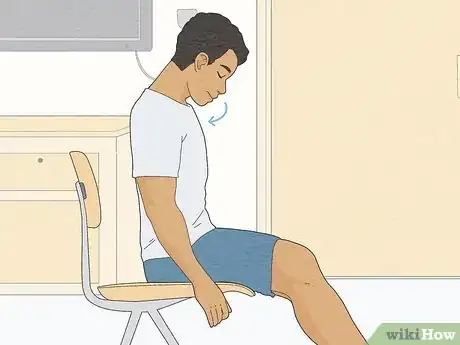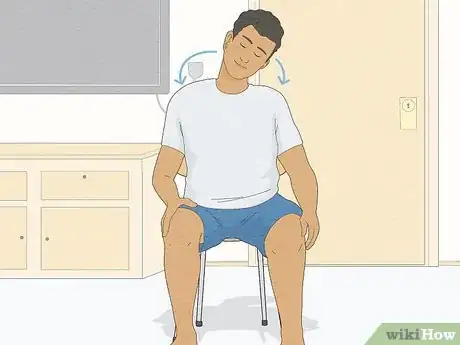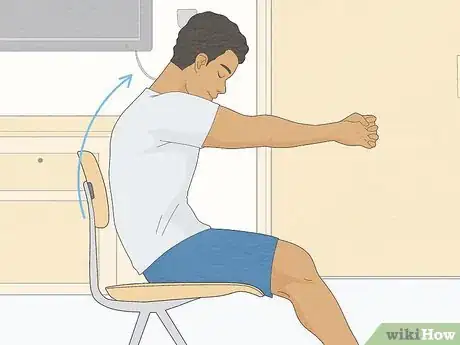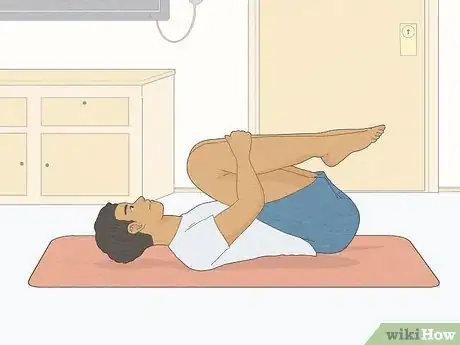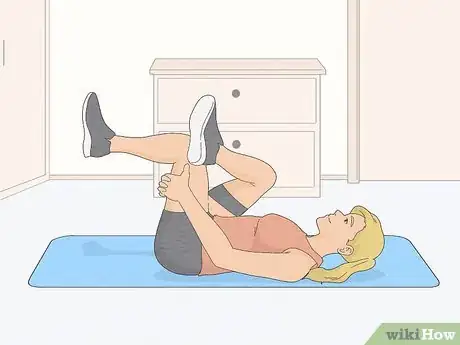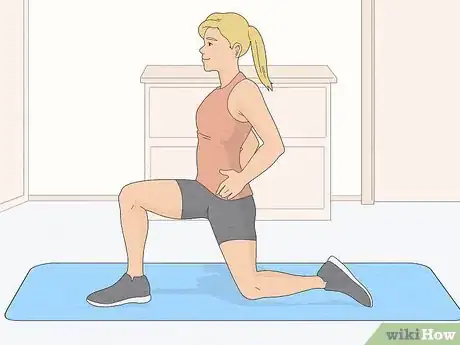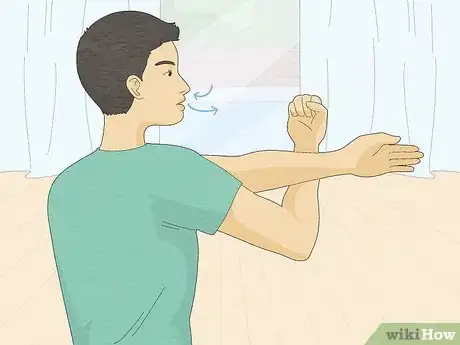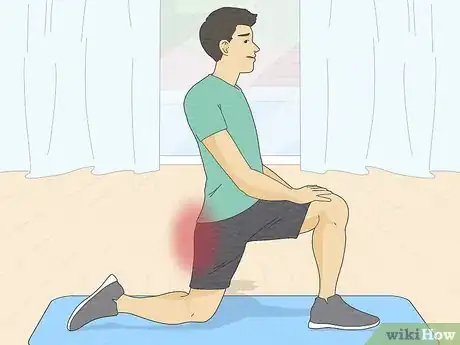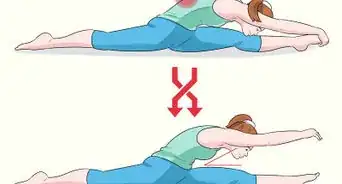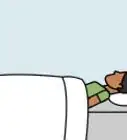This article was co-authored by Eric Christensen, DPT. Eric Christensen is a Physical Therapist based in Chandler, Arizona. With over a decade of experience, Eric works in both orthopedic and neurological fields and specializes in custom orthotic prescription and casting, vestibular reprogramming, and manual therapy. He holds a Bachelor’s degree in Exercise Science with a focus in Sports Medicine from Colorado State University and a Doctor of Physical Therapy from Regis University. In practice, Eric takes a developmental approach to rehabilitation utilizing the Selective Functional Movement Assessment. He uses functional movement patterning and manual therapy to return patients to prior levels of function.
There are 11 references cited in this article, which can be found at the bottom of the page.
This article has been viewed 38,576 times.
When you're feeling really stressed out, one of the best ways to make yourself feel better quickly is to do a few stretches combined with some deep breathing. Breathing deeply and stretching your muscles can help calm your mind and relax your body. There are also some stretches that can help specifically with stress reduction. Give a few a try and you may feel a whole lot better afterward.
Steps
Neck and Back
-
1Drop your chin and push on the back of your head to stretch your neck. Target the back of your neck, which can often hold a lot of stressful tension, by leaning your head forward, moving your chin toward your chest. Place your hands on the back of your head and gently push down until you feel a slight stretch. Breathe steadily while you hold the stretch for about 20-30 seconds and then slowly release it.[1]
- Take long, slow breaths while you stretch.
- Repeat the stretch 2-5 times.
-
2Bring your ear to your shoulder to stretch your upper trapezius. Focus on the side of your neck and your upper trapezius (the large upper back muscle located behind your neck and shoulders) by slowly leaning your head to 1 side, bringing your ear toward your shoulder. Hold a gentle stretch for about 30 seconds and then release it and do the stretch on the opposite side so you’re balanced.[2]
- A lot of folks carry stress in their shoulders and trapezius, so this stretch may be a helpful solution.
- If you’re seated, you can hold onto the chair with 1 hand to stabilize yourself.
- Stretch each side twice for a deep, relaxing stretch.
- For a deeper stretch, interlace your fingers behind your back.[3]
Advertisement -
3Round your back and push your hands forward to stretch your upper back. Clasp your hands in front of you and hold your arms parallel to the floor. Keep your head nice and relaxed and round your upper back. Push your hands forward away from your body as far as you can until you feel a deep, tension-relieving stretch in your upper back. Hold the stretch for 20-30 seconds and then gently release it.[4]
- You may not even have noticed how much tension you’ve been holding in your back while you’re stressed. Use this movement to help release it.
- Make sure you don’t hold your breath during the stretch.
- Repeat this stretch 2-5 times until you feel like your upper back is loosened up and relaxed.
-
4Lie down and pull your knees to your chest to stretch your lower back. Lay down on the floor or on top of a mat so you’re flat on your back. Pull your knees into your chest and focus on breathing and releasing any tension you’re holding in your muscles. Hold the position for about 30 seconds and then gently release it.[5]
Legs
-
1Cross 1 foot over the other knee to stretch your glutes. Your glutes can hold a lot of tension if you’re stressed, and stretching it out can help release it. Sit with your feet flat on the ground and bring your left foot over your right knee to create a figure four shape. Then, gently press on your left knee to stretch your glute. Hold the stretch for a few seconds, then release it.[6]
- Try out a few reps on each leg to stretch your glutes evenly.
- If you want to deepen the stretch, lay on your back, cross 1 leg over the other, and hug your knee to your chest.[7]
-
2Extend 1 leg and reach over it to stretch your hamstring. Keep 1 leg bent at the knee and stretch the other leg straight out in front of you. Lean over your extended leg and reach as far as you can to stretch the hamstring of your extended leg. Hold the stretch for 10-15 seconds and then release it. Switch legs and repeat the stretch on the other side.[8]
- If you’re tense and stressed, your hamstrings can hold a lot of extra tension. Stretching them out can help you relax and calm your mind.
- Try exhaling slowly as you release the stretch to ease your tension.
- A toe touch is another easy way to stretch your hamstring.[9]
-
3Lie down and use a towel to pull your leg toward your chest. Lay on your back with your knees bent and feet flat on the floor. Extend 1 leg up toward the ceiling, but keep your knee slightly bent. Place a dish or hand towel behind the back of your extended leg or on the ankle and hold both ends of the towel. Gently pull the towel toward your chest to stretch the entire backside of your leg. Hold the stretch for about 20-30 seconds and then release it. Switch legs and repeat the stretch.[10]
- Don’t put the towel behind your knee or you won’t stretch your calves.
- Repeat the stretch 2-5 times on each leg.
-
4Kneel and push your hips forward to stretch your hip flexors. Get into a kneeling position with 1 knee bent in front of your body. Keep your chest up and your back straight and gently push your hips forward until you feel a stretch in the front of your hip. Hold the stretch for 30 seconds and then repeat it on the other side.[11]
- Try stretching each side twice to really open up your hips.
- You can also stretch your hip flexors while lying down on a table. Just slide your body to the side of the table and drape 1 leg over the side, keeping it bent at the knee.[12]
Stretching Tips
-
1Breathe deeply and evenly while you stretch. Take long, slow breaths through your nose and slowly exhale out of your mouth with control. Avoid holding your breath while you stretch. Breathe deeply and evenly throughout each movement to help improve your flexibility and relax.[13]
- Try breathing exercises to help relax and ease your stress.
- The extra oxygen from deep breathing can help relieve stress and anxiety.
-
2Keep your stretches smooth and slow. Listen to your muscles as you stretch and try not to push them past their limits. Don’t bounce or jerk while you stretch or it could lead to an injury. Instead, stretch slowly and focus on your breathing to improve your flexibility and relieve your stress.[14]
- A painful muscle injury is a surefire way to increase your stress! Take it easy and keep it smooth.
-
3Avoid stretching to the point of pain or discomfort. You should feel some slight tension and pull on the muscle that you’re stretching, but there shouldn’t be any pain.[15] Find that tension and hold it to stretch in a healthy way that won’t lead to injuries. If you do feel pain when you stretch, slowly back off and avoid stretching that area.[16]
- If the pain is persistent, see your doctor to make sure there isn’t an underlying injury.
-
4Try yoga for a guided stretching and breathing practice. Yoga is an excellent combination of exercise, stretching, and breathing exercises that can be great for relieving stress. Look for a yoga studio in your area and check out a class to see if you like it. You can also use instructional videos or join online classes to try out some yoga at home.[17]
- Many yoga studios will let you check out your first class for free.
- Doing yoga with a licensed practitioner can help make sure you’re doing the movements correctly.
-
5Aim to exercise for at least 15-20 minutes every day to help prevent stress. Exercise is important for staying healthy and reducing your stress. Plus, if you feel good, it may help you feel less anxious and stress out. Aim to walk at least 2 miles (3.2 km) a day or try out 15-20 minutes of vigorous exercise such as running, biking, or swimming.[18]
- Try adding in some strength training 2-3 times a week in addition to your stretching to have a balanced, healthy exercise program.
Should I Stretch Every Day?
Community Q&A
-
QuestionWhat's the easiest yoga for beginners?
 Eric Christensen, DPTEric Christensen is a Physical Therapist based in Chandler, Arizona. With over a decade of experience, Eric works in both orthopedic and neurological fields and specializes in custom orthotic prescription and casting, vestibular reprogramming, and manual therapy. He holds a Bachelor’s degree in Exercise Science with a focus in Sports Medicine from Colorado State University and a Doctor of Physical Therapy from Regis University. In practice, Eric takes a developmental approach to rehabilitation utilizing the Selective Functional Movement Assessment. He uses functional movement patterning and manual therapy to return patients to prior levels of function.
Eric Christensen, DPTEric Christensen is a Physical Therapist based in Chandler, Arizona. With over a decade of experience, Eric works in both orthopedic and neurological fields and specializes in custom orthotic prescription and casting, vestibular reprogramming, and manual therapy. He holds a Bachelor’s degree in Exercise Science with a focus in Sports Medicine from Colorado State University and a Doctor of Physical Therapy from Regis University. In practice, Eric takes a developmental approach to rehabilitation utilizing the Selective Functional Movement Assessment. He uses functional movement patterning and manual therapy to return patients to prior levels of function.
Physical Therapist Try the cobra pose! Lie face-down on the floor with your hands centered beneath your shoulders. Then, slowly lift your head and shoulders off the ground while keeping your hips on the floor. Slightly arch your back, but make sure you aren't straining it in the process.
Try the cobra pose! Lie face-down on the floor with your hands centered beneath your shoulders. Then, slowly lift your head and shoulders off the ground while keeping your hips on the floor. Slightly arch your back, but make sure you aren't straining it in the process. -
QuestionWhat is the siddhasana pose?
 Community AnswerSiddhasana is a seated asana suitable for meditation. Siddhasana stretches the hips, knees, and ankles. It also strengthens the core muscles, including the abdomen and the back.
Community AnswerSiddhasana is a seated asana suitable for meditation. Siddhasana stretches the hips, knees, and ankles. It also strengthens the core muscles, including the abdomen and the back. -
QuestionHow do you do the pigeon stretch?
 Community AnswerSit on a flat surface and place one leg behind you. With your other leg, bend it so that it is in line with your torso, and put your hands on either side of you. Sit up straight and tall, and breathe normally. Hold this pose for about 15-20 seconds.
Community AnswerSit on a flat surface and place one leg behind you. With your other leg, bend it so that it is in line with your torso, and put your hands on either side of you. Sit up straight and tall, and breathe normally. Hold this pose for about 15-20 seconds.
Warnings
- If you feel pain or discomfort, don’t try to stretch through the pain. It could lead to further injury.⧼thumbs_response⧽
References
- ↑ https://www.nbcnews.com/better/lifestyle/5-stretches-will-relieve-neck-pain-tension-ncna1033846
- ↑ https://advancedkinetics.com/stretching-to-relieve-stress/
- ↑ https://www.nbcnews.com/better/lifestyle/5-stretches-will-relieve-neck-pain-tension-ncna1033846
- ↑ https://www.healthywomen.org/content/article/stretching-relieve-stress
- ↑ https://youtu.be/BLIKQwHITyc?t=286
- ↑ https://www.gq.com/story/how-to-stretch-for-stress-relief
- ↑ https://www.runnersworld.com/training/a28708481/glute-stretches/
- ↑ https://www.health.com/fitness/stretches-anxiety-stress-video
- ↑ Eric Christensen, DPT. Physical Therapist. Expert Interview. 17 March 2021.
- ↑ https://www.gq.com/story/how-to-stretch-for-stress-relief
- ↑ https://advancedkinetics.com/stretching-to-relieve-stress/
- ↑ Eric Christensen, DPT. Physical Therapist. Expert Interview. 17 March 2021.
- ↑ https://uhs.berkeley.edu/sites/default/files/wellness-mindfulstretchingguide.pdf
- ↑ https://shcs.ucdavis.edu/blog/archive/healthy-habits/why-stretching-extremely-important
- ↑ Eric Christensen, DPT. Physical Therapist. Expert Interview. 17 March 2021.
- ↑ https://shcs.ucdavis.edu/blog/archive/healthy-habits/why-stretching-extremely-important
- ↑ https://www.health.harvard.edu/staying-healthy/exercising-to-relax
- ↑ https://www.health.harvard.edu/staying-healthy/exercising-to-relax
